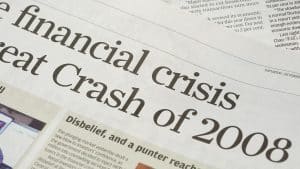Ask most people where they would go for a loan, and the answer is usually their bank. But what about when the banks can’t, or won’t, lend? The commercial disruption and consequent financial ramifications, first of the financial crisis and now more dramatically COVID-19, have challenged the banks’ primacy in the lending arena.
 As a direct result of the financial crisis in 2008, regulators sought to build up bank liquidity and limit leverage. Basel III was introduced which required banks to maintain appropriate leverage ratios, sufficient levels of reserve capital and introduce countercyclical measures. These requirements are assessed on an annual basis and revised to minimise the risk of system-wide shocks and prevent future economic collapses.
As a direct result of the financial crisis in 2008, regulators sought to build up bank liquidity and limit leverage. Basel III was introduced which required banks to maintain appropriate leverage ratios, sufficient levels of reserve capital and introduce countercyclical measures. These requirements are assessed on an annual basis and revised to minimise the risk of system-wide shocks and prevent future economic collapses.What did this mean for borrowers? Loans were more difficult to secure, requirements on collateral became stricter and other terms and conditions became more restrictive.
In 2020, Basel III ratios for banks were revised upwards again (meaning more capital was required against risk-weighted assets), COVID-19 was announced a pandemic by the WHO and global financial markets crashed. Consequently, banks have been driven into preservation mode as they wrestle with lower profits due to the introduction of interest rate cuts and higher cost of risk with a deterioration in asset quality.
In addition, most commercial banks across the Gulf have rationalized their balance sheets to focus on assets deemed safer in light of a combination of sector, business model and maturity stage, as such there has been an increase in lending to Government / government related entities, large-cap corporates and reinforcing the challenge of accessing finance from banks for many small, medium and mid-cap businesses.
The real estate sector is a prime example of where we are seeing a significant liquidity issue, as banks shy away from financing any except government-backed assets and developers are unable to unlock funds as usual from their existing projects to recycle into new ones.
The second port of call is usually debt capital markets, i.e. issuance of bonds or sukuks which can be listed and / or traded over the counter. There are many advantages for companies to raise a bond, including more flexible terms and non-amortising structures. That said, it is a long process, operating history of three years is preferred, ratings sometimes required and financial information about the company must be disclosed publicly. Specialist advisors and investment banks, including SHUAA Capital, assist companies in issuing bonds but it is a long process and is subject to investor demand at the time of issuance.
 So where do businesses turn now? Step forward ‘alternative finance’. Simply put, alternative finance enables businesses to access quick, efficient, and flexible private debt from a source outside the traditional banking and capital market structures – hence ‘alternative’.
So where do businesses turn now? Step forward ‘alternative finance’. Simply put, alternative finance enables businesses to access quick, efficient, and flexible private debt from a source outside the traditional banking and capital market structures – hence ‘alternative’.What is stopping businesses from taking advantage of such attractions?
Misperceptions remain, with many business owners mistakenly viewing it as more expensive and many investors viewing it as riskier and only for ‘bad credit’. In fact, alternative finance providers are typically well-established financial institutions with the ability to quickly assess an opportunity, consider individual requirements of borrowers and provide a bespoke solution that gives borrowers the flexibility they need whilst still protecting the interests of the lender.
These advantages enable businesses to access capital often far more quickly than via traditional methods and without some of the restrictive requirements, including tailored covenants and non-amortizing structures.
A deal which SHUAA completed in Dubai’s hospitality sector is a case in point. With a project already 85% complete, the developer needed further funding – which the senior lender was unwilling to provide. Due to leverage covenants, the developer was unable to raise debt from other sources and because the asset was under construction the developer was unable to raise equity at an acceptable valuation. SHUAA was able to fulfil the complex requirements of the transaction through a preferred equity instrument, with a minimum return payable at maturity, thus allowing the project to complete successfully without any impact on their existing bank facilities and no dilution for the shareholders. The hotel commenced operations shortly after our investment, and the owners were able to refinance the entire capital structure, repaid the existing debt, redeemed the preferred equity and released some cash to the shareholders.
So, businesses can find that alternative finance in fact represents an ideal funding instrument: quick and more flexible than bank debt without the complications of issuing a bond . Meanwhile, for investors, it offers the potential to participate in interesting business opportunities at a lower point on the risk curve than equity with attractive returns.
All of which makes the “alternative” a viable and appealing option, and that is why in the current crisis, we see the potential for alternative finance to support the region’s economic recovery.
As the youngest and now third largest asset class in the private capital universe, global private debt assets under management (AUM) have consistently grown and are expected to reach USD 1 trillion by 2021. The “alternative” is playing an increasingly important role on the global stage to cater to an everchanging environment and the expectation is that the trend will continue, particularly in markets such as the GCC.
Disclaimer
The content of this article is informational only and based on information available when created. It is not an offer or a solicitation nor is it tax or legal advice. It does not consider your financial circumstances and objectives and may not be suitable for you.

Author:
Natasha Hannoun Mansour
Head of Debt at SHUAA Capital
